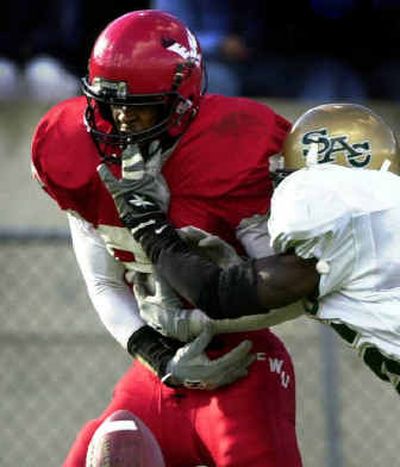Ex-player sues EWU over injury

OLYMPIA – A former Eastern Washington University football player has filed a $1 million claim against the school, claiming it allowed him to practice and play for two seasons with a stress-fractured shinbone.
Shaylon H. Reed, a wide receiver in 2000 and 2001, says that damage from the untreated fracture made it impossible for him to try out for an NFL team after his senior year.
“Due to the delay of diagnosis, Mr. Reed has most likely lost the opportunity to try out for professional football,” reads the claim he filed in March. “Even if in the future he is able to try out, he has lost at least two years, if not more, in playing time and wages.”
The minimum entry salary for an NFL player at the time, the complaint says, was $250,000 a year.
Eastern spokeswoman Stefanie Pettit said the university would not comment on the tort claim. Efforts to contact Reed, who now lives in California, were unsuccessful.
Reed was recruited by Eastern from Sacramento five years ago and agreed to play football in exchange for a scholarship.
Shortly before Reed came to Cheney, a Sacramento doctor diagnosed him with a stress fracture of his right tibia, according to the claim file. The doctor told Reed to do “absolutely no running or jumping” for four weeks, followed by four weeks of only using an exercise bike. After that, the doctor said, Reed could do light jogging. After a couple months of healing, the doctor also recommended follow-up X-rays.
That X-ray recommendation is a key part of Reed’s case. Despite nearly two years of frequent complaining about his lower-leg pain, he says, team officials at Eastern didn’t have his leg X-rayed until 2002.
“If Mr. Reed’s condition had been diagnosed in a timely fashion, his stress fracture could have been treated prior to either the 2000 or 2001 football season,” reads his claim. Regardless of whether he was red-shirted for one of those seasons, Reed says, his leg could have healed and he could have tried out for the pros after his senior season. Red-shirt status allows a player to practice with the team but not play.
Reed arrived at Eastern in late July 2000, about a month after the Sacramento doctor’s diagnosis. He was referred to a local doctor, who recommended some leg-strengthening exercises and an orthotic shoe insert but ordered no X-rays, according to the claim.
Reed led the Eagles in pass receiving in 2000, with 42 catches for 500 yards and two touchdowns while playing in all 11 games. But throughout the fall 2000 season, Reed complained of pain, soreness and swelling in his lower right leg. According to his claim, he was told that the pain was caused by shin splints and that he should ice the leg and “play through the pain.”
He continued to play football in the spring of 2001 and competed in track and field events at Eastern, including the long jump and pole vault. He continued to complain about pain in his right shin. An ultrasound scan was done on the leg, which was tender and discolored, according to the claim.
Reed continued to have pain through the 2001 football season, and says he was again told that it was shin splints. Playing in just nine games, his statistics fell off to 22 receptions for 333 yards and three touchdowns.
In March 2002, Reed’s leg was X-rayed, and the film showed a stress fracture in his right tibia. After another year of what the claim characterized as “conservative treatment,” the fracture still hadn’t healed. In May 2004, Reed underwent surgery in Cleveland to repair the leg.
In his complaint, Reed says that Eastern “was negligent in its failure to appropriately work up (his) complaints pertaining to his right leg during 2000 and 2001.”
As of March, when he filed the claim, Reed was reportedly still recovering from the surgery at his parents’ home in California.